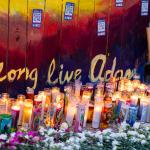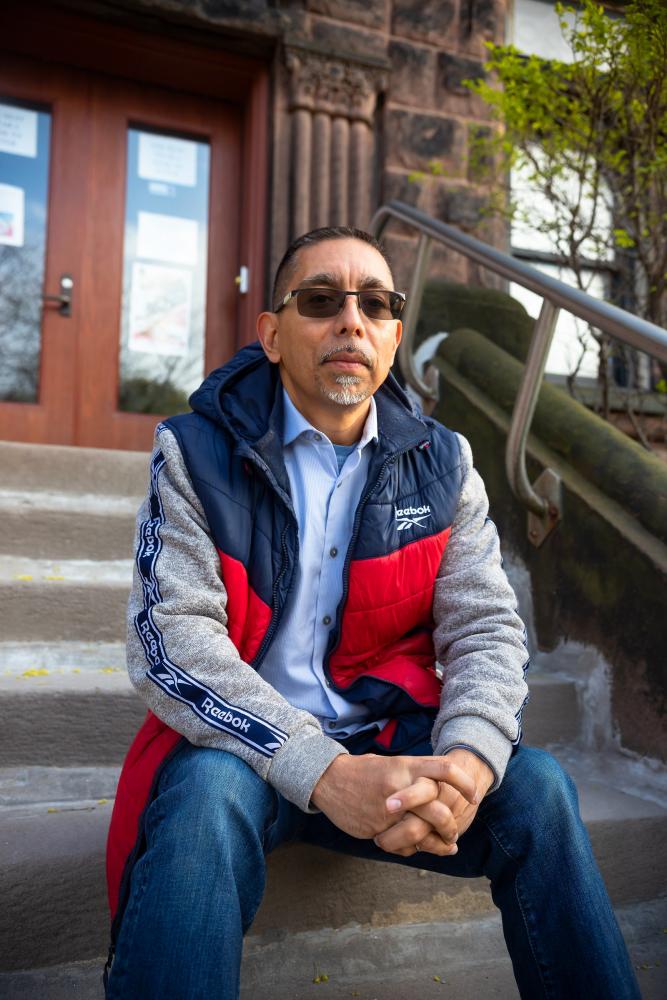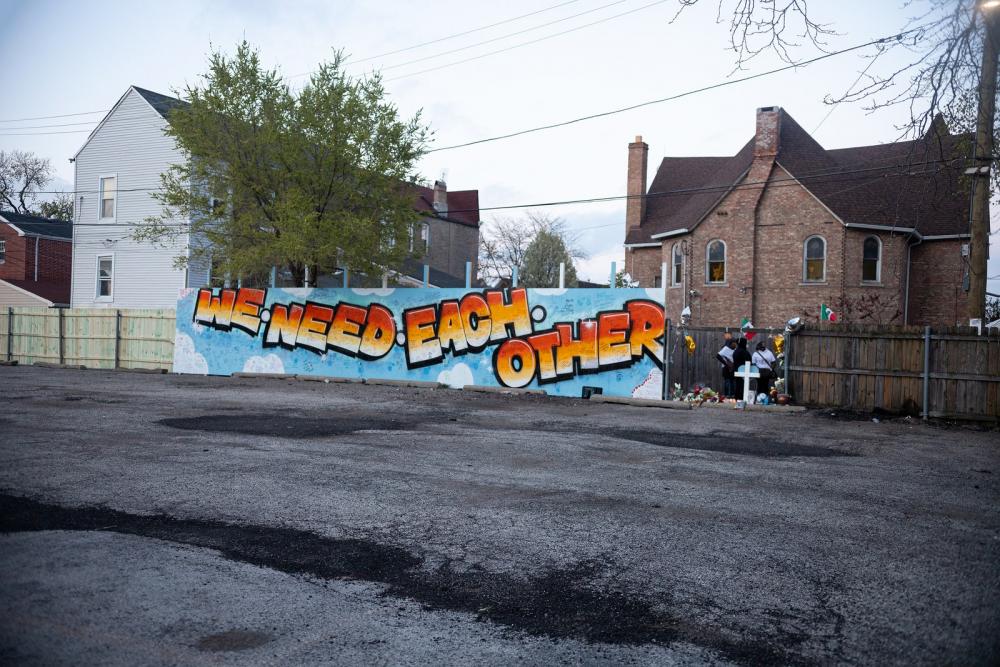The Killing of Adam Toledo and the Colliding Cycles of Violence in Chicago

Eddie Bocanegra and I met by Farragut high school in Chicago’s Little Village, a predominantly Latino neighborhood on the city’s West Side. This was, as Bocanegra said, his “old stomping ground.” He pointed out a crack along a wall and laughed. “It’s like archeology,” he told me, as he peeled back a sliver of paint to reveal layers upon layers of coats underneath, each one covering up graffiti, some of which Bocanegra contributed as a kid. We came here to talk about a recent incident. On March 29th, in an alley a couple hundred feet from the school, a police officer shot and killed Adam Toledo, who was just thirteen years old. The city released body-cam footage of the incident last week, which has led to large protests. Mayor Lori Lightfoot has called for a reconsideration of the Chicago Police Department’s policy on foot pursuits. An alderman declared that Toledo had been “executed.”
Bocanegra, who runs one of the most innovative violence-prevention programs in the country, felt compelled to watch the video of Toledo’s death. At two-thirty in the morning, the police responded to eight gunshots, which were captured on a new electronic surveillance system that detects gunfire in certain parts of the city. When the police got to the corner, they confronted Toledo, who allegedly was handed a handgun by a twenty-one-year-old man who had just fired it. Toledo ran down an alley, and an officer eventually caught up with him, by a damaged wood fence. The officer yelled, “Show me your hands!” On the video, Toledo, with his back to the officer, appears to toss the gun to the ground and quickly turn around, his hands in the air. He is wearing a white baseball cap and a Nike sweatshirt that reads “just do it.” The officer fired once and hit Toledo in the chest. He died at the scene. Bocanegra’s wife, Kathryn, an assistant professor at the Jane Addams College of Social Work, urged Bocanegra not to watch it, but he did—not once but twice. He told me that he needed to, to make up his own mind about what had happened. For three nights, he couldn’t sleep. It brought back memories of friends he’d seen shot in that same neighborhood. “It never goes away,” he said.
I wrote about Bocanegra in my book “An American Summer,” and consider him a close friend. We first met a decade ago, when he worked as a violence interrupter for an organization called CeaseFire. In that job, he roamed his neighborhood mediating disputes before they became violent. The work got to him, though, in part because people often assumed that he was still in the streets. In fact, Bocanegra self-consciously dressed in a manner that challenged people’s assumptions: dress slacks and sweaters, as if he had walked out of a J. Crew ad. Like other violence interrupters, Bocanegra had a personal history. For a long time, it was one of the first things that he’d tell you about himself—he figured people would find out anyway, and so he wanted them to hear it from him. He had belonged to a local street gang. At the age of eighteen, in retaliation for a shooting that paralyzed an older member, he shot and killed a rival gang member. Bocanegra served fourteen years in prison. Every year, on the anniversary of the shooting—July 17th—he fasts and visits with people who are struggling, often because they’ve lost a loved one to murder or to prison. His life’s work is aimed at giving back, at trying to make up for what he did.
Bocanegra, who’s forty-five, now runs readi Chicago, a program directed at young men who are among the most likely in the city to shoot someone or get shot. readi identifies them through a combination of human intelligence and data. It’s a population that most organizations don’t want to work with. The men are given jobs, which is nothing new. But they’re also required to participate in cognitive-behavioral-therapy group sessions designed to give participants tools to grapple with their trauma. In recent years, the violence-prevention field—in part, led by Bocanegra’s efforts—has focussed on recognizing signs of trauma among people whose lives have been touched by violence: difficulty sleeping, agitation, trouble concentrating, self-medicating, flashbacks. “They’re looking for a space to tell their stories,” Bocanegra said, of the therapy sessions. “Sometimes they won’t stop talking.” Representatives from a half-dozen cities have visited readi Chicago, interested in finding ways to replicate the program. Earlier this month, Bocanegra was invited to attend a ceremony at the White House, where President Joe Biden laid out new measures to curb gun violence, including evidence-based community interventions.
According to researchers at the University of Chicago’s Crime Lab, the University of Michigan, and Cornell University, who are evaluating Bocanegra’s program, early data indicates that readi is keeping more than six hundred men safer, compared with a control group that did not participate in the program. Even so, over the past year, ten young men who have passed through the program were killed in the streets. One evening, in October, Bocanegra called me and sounded troubled. He told me that Marc Nevarez, a young man whom Bocanegra had mentored as a kid—someone he adored—had been shot in the buttocks, while running from the police. He was carrying a gun. “But shot from behind?” Bocanegra asked rhetorically. “We all want public safety,” he said. “But we want public safety without getting people killed.” In Nevarez’s shooting, as in that of Toledo, the police department issued initial statements saying that officers had faced “an armed encounter.” In Toledo’s case, he was unarmed when he was shot. In Nevarez’s case, he was fleeing the police. “Get it right, man,” Bocanegra said. “This is why we have a hard time trusting the police.”
Even before Toledo’s death, trust in the Chicago Police Department was near rock bottom. In 2014, a police officer shot and killed the seventeen-year-old Laquan McDonald, and the city, at first, refused to release dash-cam video of the incident. When it was finally released, a year later, it showed McDonald being shot sixteen times as he was walking away from an officer. In 2017, the U.S. Department of Justice issued a damning report that concluded that Chicago’s police had long engaged in a pattern of using excessive force, especially against minorities. In one two-month period, last summer, the police shot five people, two of them fatally. Meanwhile, in 2020, the city saw a fifty-five-per-cent spike in homicide compared with the previous year, recording seven hundred and eighty murders. (Chicago is not the only city to see a surge in homicides. In Los Angeles, they increased thirty-seven per cent from the previous year; in New York, forty-three per cent; in Louisville, sixty-one per cent; in Phoenix, forty-six per cent.)

Eddie Bocanegra runs one of the most innovative violence-prevention programs in the country.
According to researchers at the University of Chicago’s Crime Lab, the University of Michigan, and Cornell University, who are evaluating Bocanegra’s program, early data indicates that readi is keeping more than six hundred men safer, compared with a control group that did not participate in the program. Even so, over the past year, ten young men who have passed through the program were killed in the streets. One evening, in October, Bocanegra called me and sounded troubled. He told me that Marc Nevarez, a young man whom Bocanegra had mentored as a kid—someone he adored—had been shot in the buttocks, while running from the police. He was carrying a gun. “But shot from behind?” Bocanegra asked rhetorically. “We all want public safety,” he said. “But we want public safety without getting people killed.” In Nevarez’s shooting, as in that of Toledo, the police department issued initial statements saying that officers had faced “an armed encounter.” In Toledo’s case, he was unarmed when he was shot. In Nevarez’s case, he was fleeing the police. “Get it right, man,” Bocanegra said. “This is why we have a hard time trusting the police.”
Even before Toledo’s death, trust in the Chicago Police Department was near rock bottom. In 2014, a police officer shot and killed the seventeen-year-old Laquan McDonald, and the city, at first, refused to release dash-cam video of the incident. When it was finally released, a year later, it showed McDonald being shot sixteen times as he was walking away from an officer. In 2017, the U.S. Department of Justice issued a damning report that concluded that Chicago’s police had long engaged in a pattern of using excessive force, especially against minorities. In one two-month period, last summer, the police shot five people, two of them fatally. Meanwhile, in 2020, the city saw a fifty-five-per-cent spike in homicide compared with the previous year, recording seven hundred and eighty murders. (Chicago is not the only city to see a surge in homicides. In Los Angeles, they increased thirty-seven per cent from the previous year; in New York, forty-three per cent; in Louisville, sixty-one per cent; in Phoenix, forty-six per cent.)
Bocanegra and I walked across the high school’s craggy soccer turf to the site where Toledo had been shot. Someone had painted a colorful mural on the wood fence reading “we need each other.” People had left carnations and daisies along with prayer candles and items that were reminders of Toledo’s youth: basketballs, a football, a “Star Wars” game, a stuffed animal. In addition to making the shooting particularly tragic, Toledo’s young age has made his family a target. In an interview with CNN, the head of the Fraternal Order of Police, John Catanzara, described Toledo as a gang member and as a “poor” and “misguided” kid. A local alderman at a news conference declared, “This young man had nobody.” On social media, people pointedly blamed his mother. One freelance columnist, Ray Hanania, posted, on Facebook, “Toledo’s mother should be charged with complicity in murder.” Bocanegra can’t help but think of his own mother, who moved to Texas after Bocanegra went to prison, in part to protect his younger brothers and also because she felt tarnished by his crime. Bocanegra knows what people thought—that his mom was responsible, that she could’ve done more. Speaking of the blame cast at Toledo’s mother, he told me, “It’s bullshit. This is what people said about my parents.”
Toledo lived with his mother, his ninety-year-old grandfather, and two siblings. His father was in his life. Toledo was reportedly in a special-education class. He may well have been one of the many caught in the headwinds of the pandemic—with closed schools and services leaving little support for people experiencing any kind of distress, especially in communities where resources are already thin. As we walked down the alley where Toledo had been chased, I sensed Bocanegra’s agitation. “People ask, ‘What was he doing out at two-thirty,’ or they talk shit about his mom,” he told me. “Everyone’s so quick to judge.” Toledo’s family, amid their mourning, felt compelled to issue a statement: “We . . . want to correct the hurtful and false mischaracterization of Adam as a lonely child of the street who had no one to turn to. This is simply not true. . . . Adam was not alone.”

A mural painted in Toledo’s honor near the site where he was shot.
Six years ago, I wrote a piece for The New Yorker about the police shooting of Calvin Cross, who was nineteen and Black. Cross, who had never been in trouble with the law, had been walking to a bus stop with a friend when three police officers, dressed head-to-toe in black, jumped out of a squad car, one of them wielding a military-grade assault rifle. The police claimed that they had seen Cross fidget with something in his waistband. Cross ran, and two of the officers later claimed that Cross had shot at them. The three officers shot forty-five times, eventually killing Cross at point-blank range, when they found him lying in the high brush of a vacant lot. The only gun found at the scene—across the street from Cross’s body—was so old and full of grime that it was inoperable. Moreover, it had all six bullets in its chamber. While the city settled with Cross’s family, for two million dollars, the three officers received certificates of valor. In late 2019, eight years after the shooting, the Civilian Office of Police Accountability reopened the case and concluded that one of the officers, Macario Chavez—who fired the full twenty-eight rounds from his rifle and then shot Cross with his Beretta pistol—had “showed a reckless disregard for human life.” But the city couldn’t fire him, because too many years had passed; it had allowed the statute of limitations to lapse. Instead, officials recommended a thirty-day suspension.
It’s hard for Bocanegra to disentangle the paucity of police accountability from the interpersonal violence in Chicago, which is on pace to exceed last year’s numbers. “Why do people carry guns?” he asked rhetorically. “They say they don’t feel safe. They don’t trust the police.” Last year, the Chicago police took 11,343 illegal guns off the street. The solve rate for homicides was less than fifty per cent; for shootings it was considerably lower. The police complain that too many people won’t coöperate in their investigations, but why would they if they don’t believe that the police will protect them or, for that matter, solve crimes? Marshall Hatch, Jr., a pastor on the West Side, suggested that there’s a direct relationship between state-sanctioned violence and interpersonal violence. “You have to resort to extra-legal justice, because there is no justice,” he told me, citing the belief of many in his community.
Bocanegra and I retreated from the evening chill and went for dinner at a Mexican restaurant tucked behind a small grocery store. Bocanegra can be hard on himself. At one point, when we were talking about the shooting of his protégé, Marc Nevarez, he told me, “I’m mad at the police, but I’m also mad at myself for not doing more. He’d call me and he just wanted to break bread, to get a meal together, and I couldn’t find the time because of my own family. I struggle with that.” His mention of his family reminded Bocanegra of an incident this past fall. He was driving to his father-in-law’s country home, a couple hours outside of Chicago. He was pulled over for speeding. It was nine-thirty at night, and he was driving a minivan loaded with his wife and their six children. The officer asked for his license and registration, and then walked back to his squad car. Nearly a half hour later, the officer returned, handing Bocanegra’s materials back to him, along with a ticket. “I have to ask you,” the officer asked, in earshot of the kids. “Are you still in a gang?” Bocanegra fumed. “He thought I was a nobody,” he told me. “I just hope, next time, he realizes there’s more to my story. There’s more to Adam’s story. There’s more to Marc’s story.”
As we finished up, Bocanegra told me that he plans to reach out to Toledo’s family, but he’s cautious; he doesn’t want to impose. “This is my back yard,” he explained. “This is where I grew up.” He told me that he was reserving judgment on the shooting of Toledo. “I don’t think the cop meant to do that,” he said. “And I don’t think that kid knew what he got himself into.” He tried to imagine what might have been going through Toledo’s mind at the moment that he threw the gun on the ground and turned around with his hands up. But Bocanegra stopped himself. “At the end of the day, he was just a kid,” he said. “We failed him.” He sounded unusually calm, almost resigned. “One reason I’m even-keeled is because I know it’s going to happen again,” he told me. “I have to preserve my anger.”
Alex Kotlowitz, who teaches at Northwestern University’s Medill School of Journalism, is the author of four books, including, most recently, “An American Summer.”
The New Yorker Spring Sale. Get 12 weeks for $12 $6, plus a free tote. Cancel anytime.
